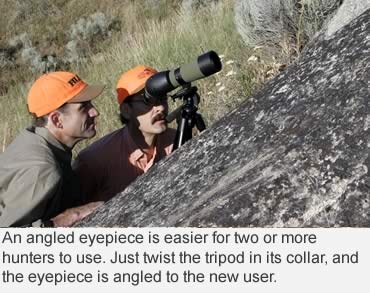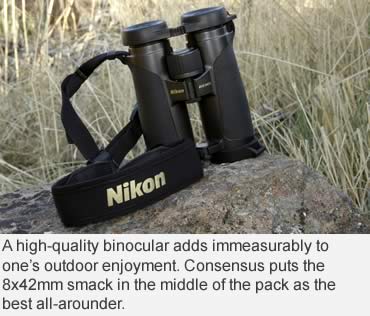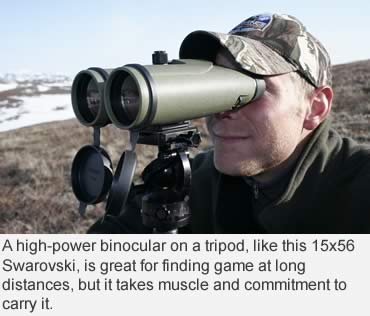Good glass and proper technique are the keys to locating game.
Photo: A straight eyepiece is not comfortable for use over long periods. It forces one to bend the neck and shoulders to see through it.
Every serious hunter has a binocular. Quite a few hunters understand the immeasurable value of a spotting scope. And nearly all hunters know you are supposed to glass, glass, glass to find game. But not everyone does it, at least not as effectively as they could.
I confess. I’m guilty. Impatient by nature, I find it all too easy to lose concentration. I feel the itch to get moving again. “There’s nothing out there, or we would have seen it. Let’s try somewhere else.”
And then a better, more persistent glasser, someone like outfitter Lance Kronberger of Alaska or Canada’s Bryan Martin, will lift his head from the spotting scope and say something like, “I just want to study the three bucks in that aspen thicket a bit longer and then double check that big one behind that boulder across from the six elk bedded in that draw.”
Huh? Where? When did you find them?
I may never be the best at finding game, but I’m smart enough to watch and learn from the pros, and they’ve taught me some great tricks that can help anyone find more game.
I lost track of who taught me what, so instead of not crediting anyone, I’m going to just throw all this together and thank all of the superb outfitters, guides and hunting partners who taught me proper glassing over the years. They’ll know who they are. And you’ll benefit as I have from their expertise.
 Rule #1: Buy, beg, borrow or steal the highest quality optics you can. Think of them as a lifetime investment. They’ll last longer than your truck, perhaps longer than your job or spouse. A good binocular or spotting scope could be with you into your 80s, and at the rate medical science is progressing, probably your 100s. Prorate that over a 60-year hunting career and even a $2,000 investment in glass costs less than 10 cents per day.
Rule #1: Buy, beg, borrow or steal the highest quality optics you can. Think of them as a lifetime investment. They’ll last longer than your truck, perhaps longer than your job or spouse. A good binocular or spotting scope could be with you into your 80s, and at the rate medical science is progressing, probably your 100s. Prorate that over a 60-year hunting career and even a $2,000 investment in glass costs less than 10 cents per day.
Most pros agree it makes more sense to spend $2,000 on hunting glass than on your rifle. Why? Because plenty of rifles selling for $400 shoot accurately enough to hit a buck every time out to 600 yards, but not if you can’t see the animal first.
Rule #2: Compromise on binocular size/power. Yes, the absolute biggest glass, all else equal, gives the best optical quality. But not if you leave it in the truck because carrying it is such an onerous chore.
Consensus puts the 8x42mm binocular smack in the middle of the pack as the best all-around choice. At 8 x, it isn’t too powerful for use in wooded cover, or too weak for seeing game way out yonder. In fact, the extra field of view of an 8x over a 10x can actually enable you to spot more game simply because you’re seeing a wider swath of country. You don’t miss animals moving at the edge of your view.
As for that 42mm objective lens, it combines with the 8x to yield a 5.25mm exit pupil, plenty wide enough to pour all the light your pupils can take in right down to 30 minutes past sunset.
A high-quality roof prism bino with phase-coated prisms, a dielectric coated mirror and fully multicoated lenses should combine with that 8x42 size to show you clear views 45 minutes to an hour after sunset, in most cases. A larger, heavier objective might buy you 5 minutes of additional viewing.
 Rule #3: Spend big on a spotting scope, and get a large one. Binoculars are best for scouring country and finding game, not for judging trophy quality. By the time you get the magnification high enough, (say 15x and higher) you’ll shake too much to use it. It’s wonderful to use a 20x binocular on a tripod, but this is a large, heavy chunk of equipment. A spotting scope will zoom from 20x to 60x, giving you much more reach.
Rule #3: Spend big on a spotting scope, and get a large one. Binoculars are best for scouring country and finding game, not for judging trophy quality. By the time you get the magnification high enough, (say 15x and higher) you’ll shake too much to use it. It’s wonderful to use a 20x binocular on a tripod, but this is a large, heavy chunk of equipment. A spotting scope will zoom from 20x to 60x, giving you much more reach.
The higher the magnification, the more critical the optics become. Power magnifies any imperfections in the system. HD and ED lenses really earn their keep at 20x and beyond by minimizing color fringing. HD glass removes the fuzz so images appear to have been cut out by a razor.
A zoom eyepiece lets you tailor power to conditions. In humid or dirty air, you might be able to use 40x. When air is perfectly clear, you can zoom to 60x and ID game miles away and even determine trophy qualities. Kronberger once identified a legal ram at five miles through a 60x80mm Swarovski spotting scope.
Get at least a 65mm objective, but go for the 80mm if possible. The 80mm is big and heavy, but at 40x, it has a 2mm exit pupil. That’s small, but larger than the 1.6 mm you get from a 65mm objective.
 Rule #4: Get steady and comfortable. An unsteady bino or spotter is equivalent to a soft, out-of-focus instrument. You want a sharp view? Lock that tool down. The higher the magnification, the more essential steadiness becomes. Most bino users can sit with elbows propped on knees and do well, but laying the bino on a jacket over a boulder is better. A light tripod and screw-in mount for the bino is more versatile. It’ll work anywhere. The tripod can then be used to hold the spotting scope, too.
Rule #4: Get steady and comfortable. An unsteady bino or spotter is equivalent to a soft, out-of-focus instrument. You want a sharp view? Lock that tool down. The higher the magnification, the more essential steadiness becomes. Most bino users can sit with elbows propped on knees and do well, but laying the bino on a jacket over a boulder is better. A light tripod and screw-in mount for the bino is more versatile. It’ll work anywhere. The tripod can then be used to hold the spotting scope, too.
For long-term viewing, you should find the angled spotting scope eyepiece more comfortable than the straight. With the straight eyepiece, you must raise the tripod and crane your head/neck high to peer through it. With the angled eyepiece, you can position the tripod low between your legs and lean your head forward to look. You can also lie supine and turn the eyepiece to see over boulders. Your partner can see what you see without anyone moving. Just turn the eyepiece toward him. If the scope vibrates in the wind, press down or add weight to it.
Rule #5: Break the ground into grids, and study each systematically. Start with the binocular, and then move to the higher-powered instrument. Move up to down or right to left. Take the ridge between two draws, and then each draw. Sweep across the skyline and the edge of the tree line.
Figure it out, break it into manageable chunks and search each area in turn. Take breaks by switching from bino to naked eye view. This rests your eyes and enables you to get the big picture. You might discover something close or out of the binocular’s field of view. After completing your scan of each section, switch back to the bino.
Rule #6: Stick with it! Resist the urge to move. You’ll find more with your eyes than legs, and you’ll cover much more country with glass than boots. But if a valley or mountainside looks empty, move during the midday lull, not during the high activity periods.
Read Recent GunHunter Articles:
• The Perfect Rifle: Planning for the next hunting gun never gets old.
• King of the Quarter Bores: The .257 Weatherby is a good alternative to the hard-thumping .30-cal. magnums.
This article was first printed in the November 2011 edition of Buckmasters GunHunter Magazine. Subscribe today to have GunHunter delivered to your home.